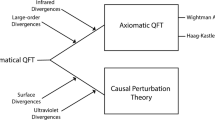Summary
It is shown why the symmetry principle between the baryon triplet (Λnp) and lepton triplet (μ eν) suggests a two-field theory of elementary particles. One massless spinor field is used to describe the nucleons and light leptons and a second spinor field with finite bare mass the « strange » particles Λ andμ. The two-field model resembles the theories of Heisenberg and Nambu in several respects but there are also important differences which are spelled out.
Riassunto
Si mostra come il principio di simmetria tra il tripletto di barioni (Λnp) e il tripletto di leptoni (μeν) suggerisca per le particelle elementari una teoria a due campi. Si usa un campo spinoriale per descrivere i nucleoni e i leptoni leggeri e un secondo campo spinoriale con massa nuda finita per descrivere le particelle « strane » Λ eμ. Sotto molti aspetti il modello a due campi è simile alla teoria di Heisenberg e di Nambu ma esistono anche notevoli differenze che si mettono in evidenza.
Similar content being viewed by others
References
S. Sakata:Prog. Theor. Phys.,16, 686 (1956); This type of theory is similar to that ofE. Fermi andC. N. Yang:Phys. Rev.,76, 1739 (1949); cfr. alsoM. M. Lévy andR. E. Marshak:Suppl. Nuovo Cimento,11, 366 (1954).
W. E. Thirring:Nucl. Phys.,10, 97 (1959); see alsoY. Yamaguchi:Prog. Theor. Phys. Suppl.,11, 1, 37 (1959); andM. Ikeda, S. Ogawa andY. Ohnuki:Prog. Theor. Phys.,22, 715 (1959); and23; 1073 (1960).
A. Gamba, R. E. Marshak andS. Okubo:Proc. Nat. Acad. Sci.,45, 881 (1959).
V. I. Goldanski:Nucl. Phys.,6, 531 (1958);O. Klein:Arkiv. Swed. Acad. Sci.,16, 191 (1959);I. Saavedra:Nucl. Phys.,10, 6 (1959).
Z. Maki, M. Nakagawa, Y. Ohnuki andS. Sakata:Prog. Theor. Phys.,23, 1174 (1960);Y. Katayama andM. Taketani: preprint (Kyoto);M. E. Mayer:Nuovo Cimento,17, 802 (1960).
H. P. Dürr, W. Heisenberg, H. Mitter, S. Schlieder andK. Yamazaki:Zeits. Naturfor.,14 a, 441 (1959); hereinafter we shall call this the Heisenberg theory.
Y. Nambu andG. Jona-Lasinio: preprint (University of Chicago); this will be referred to as the Nambu theory. Cfr. alsoJ. Goldstone: CERN preprint.
R. Haag:Kgl. Danske Videns. Selb. Mat. Fys. Medd.,29, 12 (1955);P. W. Hall andA. S. Wightman:Kgl. Danske Videns. Selb. Mat. Fys. Medd.,31, 5 (1957).
Seee.g. F. Riesz andB. Sz. Nagy:Functional Analysis, 2nd. Edition (New York, 1953), pp. 367.
R. Haag: see ref. (8);L. Gårding andA. S. Wightman:Proc. Nat. Acad. Sci. 40, 617, 622 (1954);A. S. Wightman andS. Schweber;Phys. Rev.,98, 812 (1955).
R. Haag: see ref. (8);L. Van Hove:Physica,18, 145 (1952);Y. Nambu andG. Jona-Lasinio: ref. (7).
A. Touschek:Nuovo Cimento,13, 394 (1959); in this paperTouschek also shows that, under certain conditions, a doubling of states is necessary for a finite mass particle independent of the approximation when one starts with a two-component field.
However, it must be continuous with respect to the coupling constant, in view of the theorem of Rellich (see:F. Riesz andB. Sz. Nagy: loc. cit., pp. 169); this remark applies to the continuous spectrum of all theories.
The reasons are different for the two authors;Nambu discards them=0 solution since he believes that it is unstable on two counts: 1) the analogy with superconductivity (where the superconducting state is stable and the normal state is not) and 2) on the basis of a calculation of the difference between the divergent zero-point energies. However, neither argument is conclusive: 1) the normal state becomes as stable as the superconducting state in the limit of infinite volume of the superconductor which corresponds more closely to the elementary particle case with its infinite number of degrees of freedom and hence there is no reason why two solutions should not be equally stable in two orthogonal Hilbert spaces and 2) the meaning of the divergent zero-point energy is unclear at the present stage of quantum field theory. On the other hand, Heisenberg effectively discards them=0 solution since he wishes to describe the leptons by means of the « scale » transformation. Besides, in the Heisenberg theory, the propagator function is chosen in such a way that it is zero form=0 and therefore it is self-consistent to discard them=0 solution.
Such a distinction has already been made for different purposes byY. Takahashi:Nuovo Cimento,1, 414 (1955).
S. Okubo: CERN preprint.
W. Pauli:Nuovo Cimento,6, 204 (1957); however, the possible existence of such a transformation was already noted byS. Kamefuchi andS. Tanaka:Prog. Theor. Phys.,14, 225 (1955).
H. P. Dürr: preprint (Münich).
Actually, in this case, the conservation of the current implies the separateC andP invariance of the matrix elements:W. E. Thirring:Nucl. Phys.,14, 565 (1960).
Recently,Heisenberg (private communication) has given an argument justifying this approach by using the analogy with superconductivity and ferromagnetism in still another fashion; he argues that the non-zero isospin of the vacuum is only true locally (the over-all vacuum benig symmetrical) just as the breakdown of the usual gauge invariance is only true locally (the gauge invariance returning for large distances).
L. Van Hove’s workPhysica,25, 365 (1959) in this connection is unfortunately not relevant since he could only show that in a certain model a strong interaction not satisfying a prescribed invariance principle can be converted into a strong interaction obeying the invariance principleplus a weak interaction.
W. E. Thirring:Ann. Phys.,3, 91 (1958);Nuovo Cimento,9, 1007 (1958);V. Glaser:Nuovo Cimento,9, 990 (1958).
See, however, the work byJ. Leal Ferreira andY. Katayama:Prog. Theor. Phys.,23, 776 (1960).
H. Kita andE. Predazzi:Nuovo Cimento,17, 908 (1960); have used a similar method for explaining the mass difference between the muon and electron. They utilize a strong cut-off dependence to obtain the large muon mass from zero bare mass in a way which we consider unreasonable.
W. E. Thirring:Nucl. Phys.,10, 97 (1959);14, 565 (1960).
Author information
Authors and Affiliations
Additional information
Supported by National Science Foundation, U.S.A.
Rights and permissions
About this article
Cite this article
Marshak, R.E., Okubo, S. Towards a two-field theory of elementary particles. Nuovo Cim 19, 1226–1248 (1961). https://doi.org/10.1007/BF02731399
Received:
Published:
Issue Date:
DOI: https://doi.org/10.1007/BF02731399




